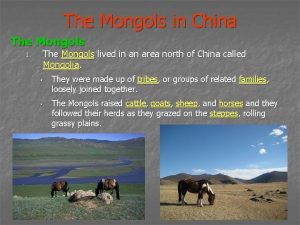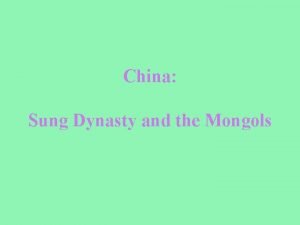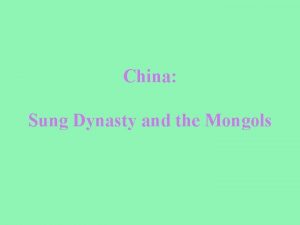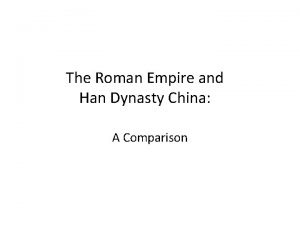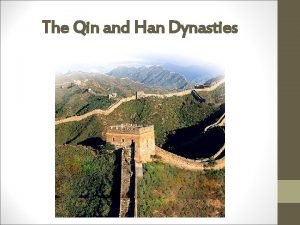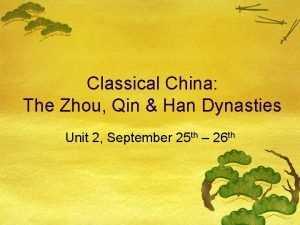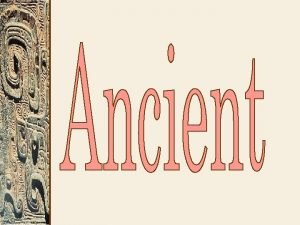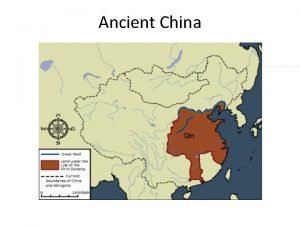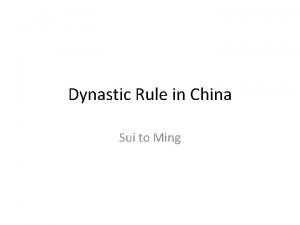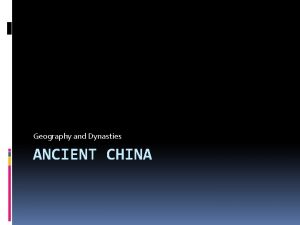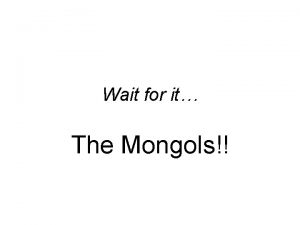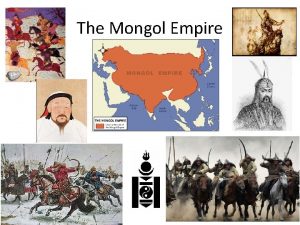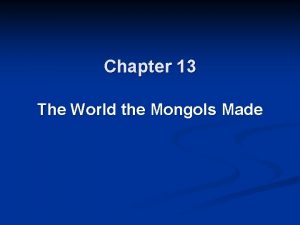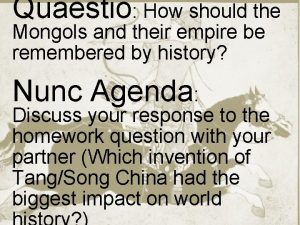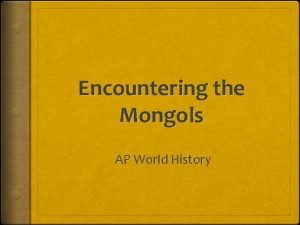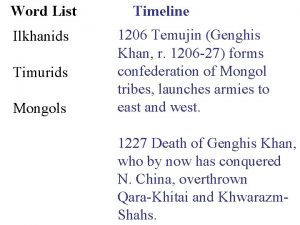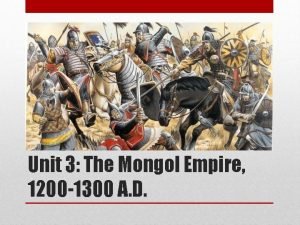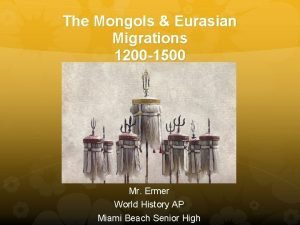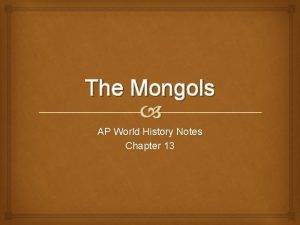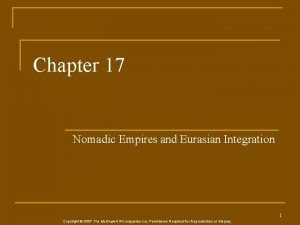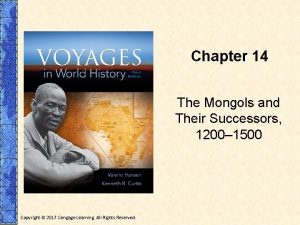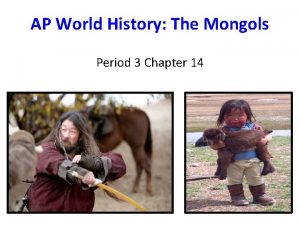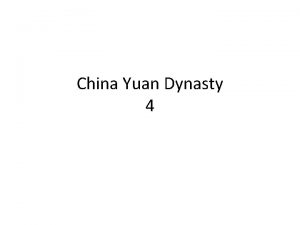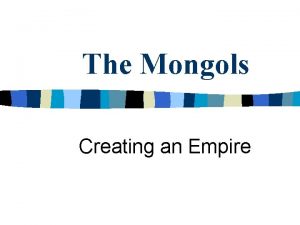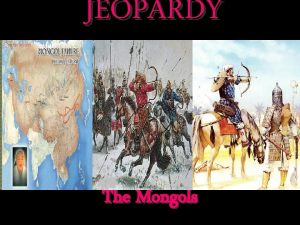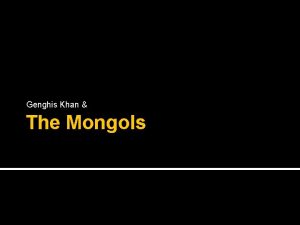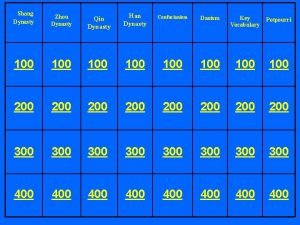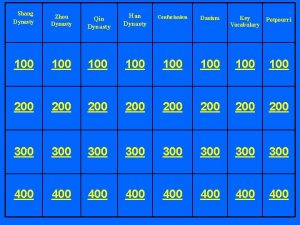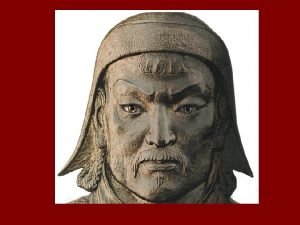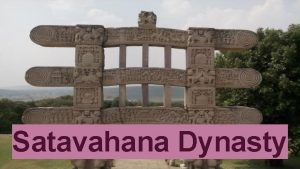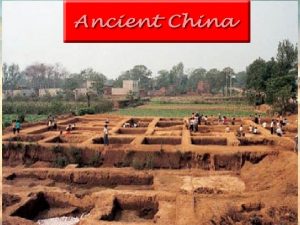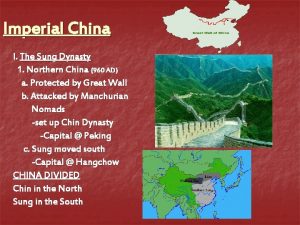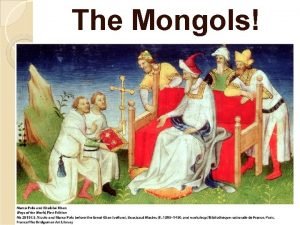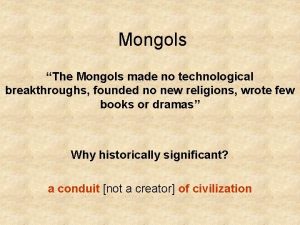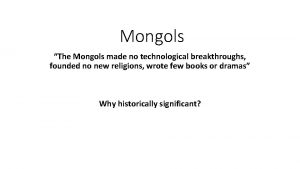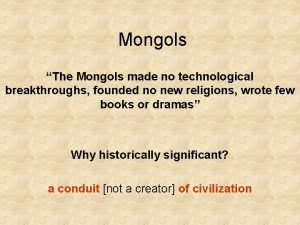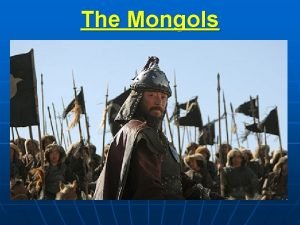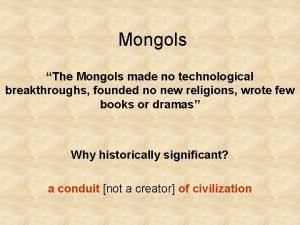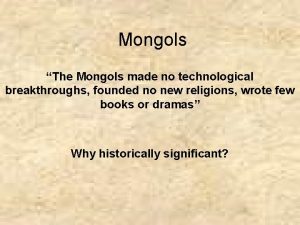China Sung Dynasty and the Mongols Sung Dynasty































- Slides: 31

China: Sung Dynasty and the Mongols

Sung Dynasty The Sung Dynasty was around from 960 until 1279. It was regarded as the end of the medieval order and the beginning of modern development. There are two time periods the Northern Sung and the Southern Sung.

Sung Dynasty Northern Sung Dynasty Artsmia. org

Sung Dynasty Chao K’ung-Yin founded the Sung. He was also know as T’ai Tsu. This portrait of T'ai-tsu shows him in imperial regalia. Chinese portrait painting emphasizes transmitting the spirit of the sitter, and Chinese physiognomy (the study of facial features) includes a type known as "imperial visage. “ Sung dynasty documents reveal that T'aitsu was so imposing that no one dared look him in the face. All portraits of T'ai-tsu were painted by Wang Ai, a native of the capital. Whether this work was done by Wang or not is an issue that remains to be studied in further detail. Npm. gov. tw

Sung Dynasty Kaifeng—near the Yellow River, it was a commercial and manufacturing center close to 1 million inhabitants. Wang An-Shih—responsible for financial policy by 1068, 80% of the governments budget went to the military. So, how was this corrected? --Personal property assessed for taxation --Corvee labor was given a wage --government loans to peasants control of prices

Sung Dynasty Wang An-shih suggesting political reforms to emperor Shen-tsung Taiwantoday. tw

Sung Dynasty Art from Minneapolis Institute of Arts Video Break http: //www. artsmia. org/art-of-asia/history/dynastysung. cfm https: //www. youtube. com/watch? v=QO 7 NHZJ-e. E 4

Sung Dynasty Grand Canal Hagen-bobzin. de

Sung Dynasty Chinatoday. com Grand Canal

Sung Dynasty Invasion and Decline Jurchen—capture the Sung capital at Kaifeng and invade northern China 1126—end of the northern Sung

Sung Dynasty Southern Sung Dynasty Artsmia. org

Sung Dynasty Southern Sung Hangchou Closer to the Yangtze river. The Yangtze delta was the southeast’s commercial center. It was wealthier and more populous then Kai-feng. It had many more merchants, artisans, shopkeepers, restaurants and teahouses. Southern Sung was more successful because of tax revenues from manufactured goods and trade.

Sung Dynasty Southern Sung Art Depts. washington. edu

Sung Dynasty Southern Sung Art Probably the most successful of the Southern Sung court landscapists was Xia Gui (active c. 1180 -1224). Pure and Remote Views of Mountains and Streams, shown previously, is unusually tall for a handscroll, almost twenty inches in height. http: //depts. washington. edu/chinaciv/painting/tptgssla. htm

Sung Dynasty Southern Sung Technology Naval ships—catapults with hurling explosive grenades. The use of a cannon, cast-metal barrels with a gunpowder propelled projectile. The use of encyclopedias and algebra was popular.

Sung Dynasty Collapse of the Sung “He who sups with the devil needs a long spoon” Sung alliance 1232 Mongols (Ogodei Khan) Jurchen

Sung Dynasty Collapse of the Sung Mongols turn against Sung Fighting between the two lasted 40 years The Mongols defeated the north and they poured into Hangchou by 1276.

Mongol empire Geography—Northern China Teachengineering. org

Mongol empire Geography Northern China Steppe Region –Flat plains area few trees —Cold and harsh winds —Little in terms of agriculture

Mongol empire Why were the Mongols so successful? Transportation—horses, the Mongols controlled the major breeding grounds. They were tough, wiry and had more stamina

Mongol empire Why were the Mongols so successful? Technology—stirrup, it gave a firmer ride on the horse and they were able to turn around.

Mongol empire Why were the Mongols so successful? Technique—False retreat and ambush. Hunting allowed them to practice their skills

Mongol Empire Yuan Dynasty Ghengis Khan History. culture-china. com Ogedai Khan History. culture-china. com Hulagu Khan Batu Khan Personal. psu. edu Kublai Khan Hightech-edge. com

Mongol empire Chinghis (Ghengis) Khan (1155 -1227)— Temujin --United the Mongols tribes through oaths and alliances --Created unity among tribes based upon common allegiance --built a strong army and in turn alliances with neighboring tribes in Central Asia. Converts to Islam

Yuan Dynasty Artsmia. org

Yuan Dynasty Government—Used the Chinese bureaucratic system of government. Employed non-Chinese, foreigners. Marco Polo (1275 -1292) served as worker. Achievements—Rebuilt the Grand Canal and roads issued paper money and started a postal system Tolerance and trade—Pax Mongolia policy of good will and tolerance toward different cultures Decline— 1350 s Mongols lose control of the Yangtze river Valley. 1368 Mongols are forced back into the steppe.

Yuan Dynasty Bhoffert. faculty. noctrl. edu

Yuan Dynasty Metmuseum. org

Yuan Dynasty Art Although it was in use in China before the advent of the Mongols, the paiza, an inscribed metal plaque that functioned as a passport or a patent of office, became a symbol of Mongol administration used to regulate and secure communication in the vast empire. Most paizi were circular or rectangular and were worn either fastened on an item of clothing or suspended from the neck to make them visible to customs officers. These metal plaques are not only important historical documents but are also of great interest for the study of Asian metalwork during the thirteenth and fourteenth centuries, a time of massive movements of people and rapid exchange of ideas and technology. Two kinds of Mongol plaques were issued–to officials as patents of office, and as passports for persons on state missions and for important guests. (Marco Polo on his return journey to Venice would have carried one. ) The paiza illustrated here is a passport, made of iron with inlay of thick silver bands forming characters in the Phagspa script, devised for the Mongol language in 1269 by the Tibetan monk 'Phagspa (1235— 1280), a close advisor to Kublai Khan (r. 1260– 95). The inscription reads in translation (by Morris Rossabi): By the strength of Eternal Heaven, an edict of the Emperor [Khan]. He who has no respect shall be guilty. Above it is a lobed handle, with an animal mask in silver inlay. The mask is probably the kirttimukha (lion mask) taken from Tibetan art but ultimately of Indian origin; the lobed shape reflects Islamic influence. Silver inlay on iron (as opposed to bronze) is extremely rare in China before the Mongol period. This plaque is one of about a dozen Mongol paizi known. Two others of the same type are in Lanzhou, China, and in Russia. (The latter example was found during the nineteenth century in Tomskaya. ) http: //www. metmuseum. org/toah/works-of-art/1993. 256

Yuan Dynasty Art Cosmological Mandala with Mount Meru, Yuan dynasty (1271– 1368) China Silk tapestry (kesi) 33 x 33 in. (83. 8 x 83. 8 cm) This mandala is in the form of the Tibetan cosmological diagram. In the center is Mount Meru, the axis of the cosmos, surrounded by oceans and mountains of the four quarters. The work is typical of the Mongol Yuan period in China: technically superb, while stylistically and iconographically eclectic—Indian, Tibetan, and Chinese elements are all present. http: //www. metmuseum. org/toah/works-of-art/1989. 140

Mongol Empire The Mongols—Crash Course World History #17 http: //www. youtube. com/watch? v=szx. Par 0 Bc. Mo
 The mongols lived in an area north of china called
The mongols lived in an area north of china called Why were the mongols so successful
Why were the mongols so successful Sung dynasty founder
Sung dynasty founder Both the han dynasty and the roman empire
Both the han dynasty and the roman empire China qin dynasty map
China qin dynasty map Ancient china roads
Ancient china roads How did the ming dynasty restore chinese rule to china?
How did the ming dynasty restore chinese rule to china? Zhou
Zhou How was china reunited under the sui dynasty
How was china reunited under the sui dynasty China zhou dynasty
China zhou dynasty Ancient china zhou dynasty
Ancient china zhou dynasty How did the sui dynasty affect daily life in china
How did the sui dynasty affect daily life in china Sui dynasty achievements
Sui dynasty achievements Chinese dynastys
Chinese dynastys Chinese dynasties
Chinese dynasties Viking vs mongol
Viking vs mongol Wait for it the mongols
Wait for it the mongols Genghis khan name
Genghis khan name Mongols chapter 13
Mongols chapter 13 How should the mongols be remembered
How should the mongols be remembered Mongols in russia ap world history
Mongols in russia ap world history Were the mongols positive or negative
Were the mongols positive or negative Ferret mongols
Ferret mongols What did the mongols do for the silk road
What did the mongols do for the silk road Mongols miami
Mongols miami Chapter 13 ways of the world notes
Chapter 13 ways of the world notes The mongols in world history webquest
The mongols in world history webquest Encountering the mongols comparing three cases
Encountering the mongols comparing three cases Tughril
Tughril Mongols
Mongols The mongols in world history
The mongols in world history Golden horde ap world history
Golden horde ap world history
